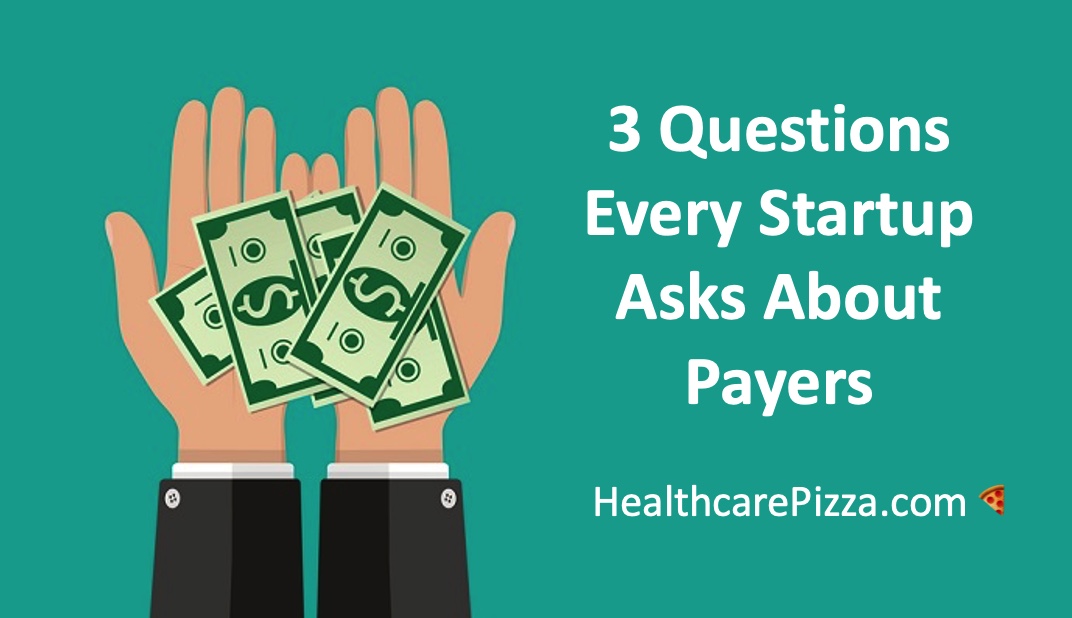3 Questions Every Startup Asks About Payers
I have recently seen a number of digital health startups recruiting for individuals to lead payer strategy and business development. This initially led me to two reactions. First, word of caution to those looking to fill the role, it is completely different to work for a payer versus successfully sell into one. Don’t just fall for someone who worked at UnitedHealthcare or Aetna, those are a very far cry from a startup (no offense). Ideally, you hire someone with experience from both. Second, far too many startups lack the robust understanding of the payer market in their existing leadership team, which could be eventually become their Achilles’ heel.

At the end of the day, unless your business model only accepts cash or credit card, which would have negative implications to individuals meeting their deductibles and out-of-pocket max spending thresholds (I’ll address another time), you must understand the payer market. Mostly because unless the incumbent reimbursement system changes, it will be incredibly difficult to make a meaningful impact in care delivery, improved outcomes, and lower cost. And no one will pay you for your work.
To help you along the journey, here’s three answers to some commonly held questions related to the payer market.
What’s so complicated about the U.S. payer market?
You can roughly break down the U.S. payer market (some people spell it “Payor” but we don’t talk to those people) into the following insured populations:
- Commercial insurance
- Large Group
- Small Group
- ACA Individual Exchange
- Medicare
- Medicare Advantage
- Medicare Fee-For-Service (FFS)
- Medicare Specialty Plans (i.e., I-SNP, D-SNP, PACE)
- Medicare Part D Plans
- Medicaid
- Medicaid Managed Care
- Medicaid FFS
- Children’s Heath Insurance Program (CHIP)
- Other Public
- Tri-Care
- Veterans Health Administration
- Indian Health Service
These sub-markets are either funded by employers, employees, individuals, or state or federal governmental entities and referred to as “lines of business” in the biz. When you think about targeting a specific line of business (LOB), it is important to remember that each LOB has unique characteristics. Someone can qualify for Medicaid and Medicare coverage, known as a “dual eligible.” Someone enrolled in a Medicaid managed care plan can receive coverage for some services directly through the state FFS program. Someone can have large group insurance, be laid off and switch to a silver ACA marketplace plan for a few months, only to be hired by a small business with fully-insured commercial insurance coverage.

Now I realize that many startups have targeted the large employer market in hopes of avoiding the payers altogether. It’s so much easier to convince your Silicon Valley brethren to pay for sweet analytics and a digital health stress ball to track calories burned when the payers are so ancient. Well, you should realize that majority of these large employers still partner with the payers to provide back office functionality (i.e., claims processing, benefit design, network contracting) and I suspect will increasingly divert all prospective startup inquiries to their payer counterparts.
It’s also not enough to know whether you think your service or product will “save” payer’s cost. You must contextualize your services or technology against all the other cost drivers and strategic priorities that the payers are dealing with.
Payers have so much money, why don’t they just give me some?
Everyone knows that the cost of medical care outpaces the rise of inflation. In the U.S., no provider, drug company, pharmacy, home health provider, medical device manufacturer or hospital wants to get paid the same as last year. Therefore, when payers think about their cost profile, they get paid based on what they can prove they need. The exchange of funds comes directly from employers, employees, individuals, and governmental entities (i.e., CMS, state Medicaid agencies).
The magnitude of scale oftentimes distorts the reality of a low margin business. These payers can have billions of dollars in premium (revenue), which would imply that there’s plenty of money to go all around. Your startup is only looking for a couple million in revenue from each deal, not too much to ask right? Wrong. The total premium dollar is broken into three buckets of spend: (1) medical spend (“Medical Loss Ratio” or “MLR”); (2) administrative spend (“Administrative Loss Ratio” or “ALR”); and (3) profit. The profit is either distributed to shareholders or sent to cover risk-based capital (RBC).

My point is that actuaries look at a range of historical factors to reasonably predict what the following years cost will include. Then they will make quarterly adjustments as more current data presents itself. To understand what goes into the sausage-making, actuaries will first look at historical claims for all medical services and prescription drugs by line of business. Claims reflect unit costs (price per service), utilization, mix and intensity of services, and plan design. After establishing this baseline, they begin to adjust the figures based on changing demographics, geographic differences, regional practice patterns, patient risk adjustments, and new state and federal laws and regulations.
If your product or service cannot demonstrably demonstrate ROI for the pain of implementation, they will not proceed. Remember that most of the premium has already been spoken for by the medical and administrative cost drivers from last year. To break the cycle, prove that you will reduce savings on the MLR or ALR side of the equation, that the savings will be guaranteed versus predicted, and that the time required to realize these cost savings is not too long.
Who are the important players in the payer market?
The good news is that the payer market is consolidated, meaning your go-to-market teams only have to close a few key deals before your company achieves meaningful scale. The bad news is that the payer market is consolidated, so you have to play by their rules and most startups are notoriously bad at managing this process.
To add some data for context, the Government Accountability Office (GAO) commissioned a study in March 2019 to analyze the commercial insurance market. What they found was staggering. In 37 states, the three largest commercial payers dominated 80% or more of the market. To go one step further, 10 states have one health plan who dominates over 75% of the large group insurance market.

Looking at the Medicare Advantage (MA) market reveals a slightly less consolidated market. In 2019, 59% of MA beneficiaries were enrolled in plans owned by either UnitedHealthcare, Humana, or a BlueCross BlueShield plan. If you were thinking, “Hell yes, I was looking to avoid the big plans so that means 41% of the other MA enrollees are in easy, small, independent payers right?” Not exactly. Unless you consider giants like Aetna, Cigna, Centene / Wellcare, and Kaiser which comprise another 21% of the market to be small. In reality, only 19% of the MA market is owned by smaller payers.
The big payers are just getting bigger, in an effort to respond to hospital consolidation and the continued switch from independent to employed physicians. And they aren’t just buying each other (which they are), but also buying the vendors that they outsource key services to. Just this month, Anthem announced the completed acquisition of Beacon Health Options, one of the largest behavioral health management companies serving 40 million lives across 50 states.
Andy Mychkovsky is the creator of Healthcare Pizza. Follow him on Twitter (@AMychkovsky) and LinkedIn for future thoughts and updates.

